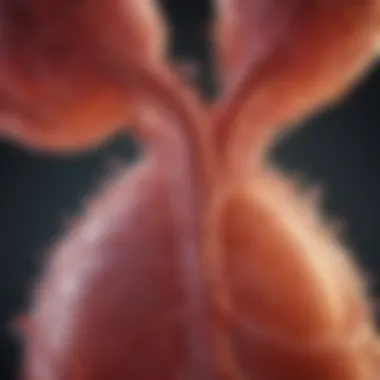Enzymes for Alcohol Metabolism: Role and Function


Intro
Understanding how the human body processes alcohol is crucial, especially considering the widespread consumption of alcoholic beverages globally. This complex biochemical process involves various enzymes that play a significant role in the metabolism of ethanol. Alcohol metabolism mainly occurs in the liver, where specific enzymes convert ethanol into less harmful substances. Identifying these enzymes and understanding their functions can shed light on how our body detoxifies alcohol and the potential health implications that arise from genetic variations in enzyme activity.
In this discussion, we will delve into key enzymes like alcohol dehydrogenase and aldehyde dehydrogenase. These enzymes are fundamental in managing ethanol consumption and its physiological effects. Furthermore, we will explore genetic factors and environmental influences that can modulate enzyme activity and how these factors may affect individual alcohol tolerance and susceptibility to alcohol-related diseases.
An in-depth analysis of these topics will offer students, researchers, educators, and professionals a comprehensive understanding of enzyme roles in alcohol metabolism, paving the way for potential future research and health implications.
Methodology
The investigation of enzymes involved in alcohol metabolism relies on a systematic and multi-faceted approach to data collection and analysis.
Study Design
A combination of laboratory experiments and observational studies has been performed. Laboratory experiments involve purifying enzymes from liver tissues and measuring their activity levels when exposed to ethanol. Observational studies look at populations with varying alcohol consumption patterns, tracking enzyme activity and genetic variations.
Data Collection Techniques
Data is collected through various techniques:
- Spectrophotomeric assays to measure enzyme activity.
- Genetic analysis using polymerase chain reaction to identify polymorphisms in alcohol-related genes.
- Surveys and questionnaires to gather information on alcohol consumption habits from different demographic groups.
This multi-pronged methodology ensures the reliability of collected data and helps correlate enzyme activity with health outcomes.
Discussion
Interpretation of Results
The research findings indicate that variations in enzymes like alcohol dehydrogenase and aldehyde dehydrogenase significantly affect how individuals process alcohol. For instance, individuals with a variant form of aldehyde dehydrogenase may experience adverse effects due to the accumulation of acetaldehyde, a toxic byproduct of ethanol metabolism. These findings contribute to the broader understanding of why certain populations are at higher risk for alcohol-related health issues.
Limitations of the Study
Despite its depth, this study has limitations. The complexity of human metabolism means that these enzymes do not operate in a vacuum; other factors like diet, age, and overall health also influence alcohol metabolism. Additionally, the sample size in some studies may not fully represent broader populations, which could affect the reliability of the results.
Future Research Directions
Future research should aim to expand upon these findings by exploring gene-environment interactions. Understanding how lifestyle factors—such as dietary choices or exercise—intersect with enzyme activity could illuminate new pathways for intervention. Furthermore, investigating the relationship between enzyme variations and specific alcohol-related diseases could pave the way for personalized medical approaches.
In summary, the study of enzymes involved in alcohol metabolism is vital for understanding not only how our bodies deal with alcohol but also the nuances that can affect individual health. Such insights can guide efforts in public health and inform clinical practices related to alcohol consumption.
Preface to Alcohol Metabolism
Alcohol metabolism is a crucial biological process that helps the body detoxify ethanol, which is the type of alcohol commonly found in beverages. Understanding this topic is vital for several reasons. First, it underscores the biochemical mechanisms that delineate how alcohol consumption affects human physiology. Second, this knowledge can inform both health practices and treatment options for conditions related to alcohol use. Finally, grasping how enzymes function in this context empowers individuals and professionals to make informed decisions regarding alcohol consumption and its potential health consequences.
Definition and Importance
Alcohol metabolism refers to the biochemical processes by which the body breaks down and eliminates alcohol. This process primarily occurs in the liver and involves a series of enzymatic reactions. The primary enzymes include alcohol dehydrogenase and aldehyde dehydrogenase, which play significant roles in converting ethanol into less harmful substances. The efficiency of these enzymes can vary widely among individuals due to genetic, environmental, and lifestyle factors. Understanding the definition and the importance of alcohol metabolism is indispensable since it can have profound implications for public health, addiction research, and even personal lifestyle choices.
The Role of the Liver
The liver is at the center of alcohol metabolism. It is not merely a filtration organ but an active participant in biochemical transformations. When a person consumes alcohol, it rapidly reaches the liver, where it is metabolized through various enzymatic pathways. Alcohol dehydrogenases are the first line of defense, converting ethanol into acetaldehyde, a toxic compound. Following this step, aldehyde dehydrogenases further metabolize acetaldehyde into acetate, which is less harmful and can be utilized for energy.
This metabolic route is vital because excessive accumulation of acetaldehyde can lead to alcohol-related tissue damage and several health issues. The liver’s capacity to metabolize alcohol can be influenced by various factors, including genetics, age, gender, and existing liver health. Moreover, the liver has a remarkable ability to regenerate itself, although chronic alcohol consumption can overwhelm its detoxification capacity, leading to serious conditions such as fatty liver disease and cirrhosis.
By understanding the critical role the liver plays in alcohol metabolism, one gains insight into the broader implications of alcohol consumption on liver health and overall well-being.


Key Enzymes Involved in Alcohol Metabolism
Understanding the enzymes that facilitate alcohol metabolism is crucial. These enzymes play a significant role in breaking down ethanol, the active ingredient in alcoholic beverages. The liver is the primary site for this metabolism, which involves complex biochemical pathways. The key enzymes include alcohol dehydrogenase, aldehyde dehydrogenase, and cytochrome P450 enzymes. Each of these enzymes contributes uniquely to the detoxification of alcohol and influences individual responses to alcohol consumption.
Alcohol Dehydrogenase
Mechanism of Action
Alcohol dehydrogenase (ADH) is the first enzyme involved in alcohol metabolism. It catalyzes the oxidation of ethanol to acetaldehyde, a highly toxic compound. This initial reaction is vital because it sets the stage for subsequent conversions. ADH operates through a process of reducing nicotinamide adenine dinucleotide (NAD+) to NADH, which is essential in energy metabolism.
The key characteristic of this enzyme is its substrate specificity and kinetic parameters. ADH is particularly popular in studies of alcohol metabolism because it illustrates how different individuals may metabolize alcohol differently. A unique feature of ADH is its variable isoforms found in humans. This variance can greatly affect the rate of ethanol metabolism.
However, while the action of ADH is necessary for detoxifying ethanol, it can also lead to the accumulation of acetaldehyde, which has adverse effects on health.
Isoforms and Variability
Different isoforms of alcohol dehydrogenase exist, which can vary significantly between individuals. This variability affects how efficiently different people metabolize alcohol. For example, some isoforms metabolize ethanol more quickly than others. The genetic polymorphisms affecting these isoforms play a crucial role in the differences in ethanol sensitivity seen in the population.
The significance of observing isoforms lies in their potential health implications. Understanding this variability helps explain why some individuals may be more prone to develop alcohol use disorders compared to others. However, the challenge is in identifying and categorizing these isoforms to fully understand their role in alcohol metabolism.
Aldehyde Dehydrogenase
Role in Acetaldehyde Metabolism
Aldehyde dehydrogenase (ALDH) follows the action of ADH. Once acetaldehyde is produced, ALDH’s task is to convert it into a less harmful substance, acetic acid. This process is essential for reducing the toxic effects of acetaldehyde, including flushing reactions and other health issues.
The main contribution of ALDH is detoxifying the intermediate product of alcohol metabolism. Its efficiency determines how quickly and effectively the body can manage alcohol consumption. The enzyme is considered beneficial due to its ability to mitigate the harmful effects of acetaldehyde.
The unique feature of ALDH is its rapid turnover in the body, allowing for quick recovery from alcohol effects. However, some individuals may have impaired ALDH activity due to genetic variations, which can lead to unhealthy levels of acetaldehyde accumulation.
Genetic Variants and Health Implications
Genetic variants of aldehyde dehydrogenase can have significant health implications. Variants in the ALD gene, for instance, lead to inactive forms of the enzyme, contributing to an increased risk of alcohol-related diseases such as esophageal cancer. Understanding these variants provides insight into individual susceptibility to alcohol-related health issues.
The key characteristic here is how these genetic factors affect alcohol metabolism and addiction risk. Identifying individuals with the variant allows for personalized health strategies, but the challenge lies in the stigma and social implications often associated with alcohol use disorders.
Cytochrome P450 Enzymes
Function in Alcohol Metabolism
Cytochrome P450 enzymes are another key player in alcohol metabolism, particularly in the oxidative pathway. They play a role when ethanol consumption exceeds the liver’s capacity to process it through traditional methods. CYP2E1, one isoform, becomes more active during chronic alcohol consumption, leading to increased production of harmful metabolites.
The unique function of these enzymes is their ability to process a wide range of substances, making them versatile. However, their activity can generate reactive oxygen species, which can cause cellular damage, presenting a disadvantage in prolonged high-level alcohol consumption.
Interaction with Other Substances
Cytochrome P450 enzymes interact with many drugs and substances. This can complicate treatment regimens because alcohol can modify the metabolism of medications. For example, combining alcohol with medications that are also metabolized by CYP2E1 can lead to adverse drug reactions.
The importance of these interactions highlights the risks of consuming alcohol with certain drugs, underscoring the need for caution. The variability in cytochrome P450 enzyme activity based on genetic factors adds another layer of complexity to this topic.
Understanding the role of key enzymes in alcohol metabolism not only aids in recognizing individual differences in alcohol processing but also illuminates pathways for treatment of alcohol use disorders.
The Metabolic Pathway of Alcohol
Understanding the metabolic pathway of alcohol is essential for grasping how the body processes ethanol. The impact of alcohol consumption on health and physiology largely depends on how efficiently alcohol is metabolized. This pathway involves multiple steps, primarily occurring in the liver, which transforms ethanol into non-toxic products. Knowing these processes aids in comprehending the biochemical interactions that occur following alcohol intake.


Primary Pathways
Oxidative Pathway
The oxidative pathway is the dominant route of alcohol metabolism. In this process, alcohol dehydrogenase initiates the breakdown of ethanol. This enzyme converts ethanol into acetaldehyde, a compound that is further metabolized by aldehyde dehydrogenase into acetic acid. A significant characteristic of this pathway is its reliance on NAD+ as a coenzyme, which is reduced to NADH. This conversion is crucial as it directly ties into cellular energy production.
The oxidative pathway is advantageous because it effectively detoxifies ethanol, minimizing hepatotoxic effects. However, its downside lies in acetaldehyde, which is toxic and can lead to health issues if not managed properly. The oxidative pathway serves as a clear illustration of how the body manages alcohol, making it a fundamental focus in this article.
Non-Oxidative Pathway
In contrast to the oxidative pathway, the non-oxidative pathway utilizes different mechanisms for alcohol metabolism. This pathway is less prominent but nevertheless noteworthy. It involves the conjugation of ethanol with other molecules, such as the formation of fatty acid ethyl esters. A key aspect of this pathway is that it does not require oxygen, making it useful under conditions where aerobic metabolism is impaired.
The non-oxidative pathway may be beneficial in certain scenarios where rapid detoxification is needed, but it does not fully eliminate ethanol from the body. Its unique feature lies in its ability to generate various metabolites, which can have differing health implications. While this pathway demonstrates versatility, the potential for generating harmful products raises concerns regarding its overall impact on health.
Role of NAD+ in Metabolism
NAD+ plays a pivotal role in alcohol metabolism, particularly in the oxidative pathway. It acts as a crucial coenzyme, participating in redox reactions and energy transfer within cells. When ethanol is metabolized, NAD+ is reduced to NADH, affecting the cellular energy balance.
An important consideration is the ratio of NADH to NAD+. High levels of NADH can lead to lactic acidosis and disrupt various metabolic processes. This indicates a delicate balance that must be maintained to prevent adverse effects on health. Understanding this role of NAD+ is integral for grasping how alcohol affects metabolic states and overall health.
Factors Affecting Enzyme Activity
Understanding the factors that affect enzyme activity is crucial in the context of alcohol metabolism. Enzyme efficiency does not only depend on the inherent properties of the enzymes themselves. External influences, genetic variations, and biological differences play significant roles. Evaluating these factors reveals how body metabolism of alcohol can differ among individuals. This information is especially relevant for healthcare professionals and researchers aiming to understand alcohol's varied effects on health.
Genetic Factors
Polymorphisms in Enzyme Genes
Polymorphisms refer to variations in the genetic code that can influence enzyme function. They can change how an enzyme operates, leading to different levels of activity. For instance, variations in the ADB gene affect alcohol dehydrogenase's efficiency. Some people possess alleles that make the enzyme work faster, while others have variants that reduce its activity. These differences can impact how individuals metabolize alcohol.
The presence of specific polymorphisms can be a popular topic in genetic studies. Particularly, understanding these variations can aid in developing personalized medicine approaches for alcohol-related health issues. Genetic testing for these traits can be a valuable tool in clinical settings.
A unique feature of these polymorphisms is their association with conditions like alcoholism. Individuals with certain variations may be more susceptible to developing alcohol dependency due to slower metabolism of alcohol by their bodies. Such insights provide a clearer picture regarding the genetic predisposition to addiction, making this subject essential for the overall article.
Impact on Ethanol Sensitivity
Ethanol sensitivity refers to how individuals respond to ethanol exposure. This sensitivity can greatly vary because of genetic differences in enzyme activity. Factors like adverse reactions or discomfort after consuming alcohol can link back to genetic profiles.
This aspect of metabolism is a critical field of study, as it highlights why some people can consume alcohol without significant effects while others cannot. Such differences are beneficial in understanding public health discussions surrounding alcohol policy and health education.
Although some might find the topic complex, it remains essential for comprehending disparities in alcohol-related health outcomes. These variances can lead to either protective factors or increased risks in health impairment.
Environmental Influences
Diet and Lifestyle
Diet and lifestyle choices significantly influence how enzymes function in alcohol metabolism. Different diets can impact the availability of nutrients necessary for enzyme activities. For example, high levels of antioxidants may help protect the liver from ethanol-related damage, influencing overall enzyme function during alcohol consumption.
Lifestyle factors like physical activity also have a substantial effect. Regular exercise can enhance metabolic processes, including alcohol metabolism. Therefore, discussing these elements provides a holistic view of how various factors intertwine to affect enzyme activity.
Understanding diet and lifestyle choices is beneficial for crafting comprehensive health guidelines. Such knowledge allows healthcare professionals to recommend personalized lifestyle changes to improve individual health outcomes among alcohol consumers.
Drug Interactions
Drug interactions can significantly alter enzyme activity, particularly in the context of alcohol metabolism. Many medications can inhibit or induce enzyme function. For instance, substances like ketoconazole can inhibit certain cytochrome P450 enzymes, affecting how the body processes alcohol.


Discussing drug interactions enriches the article by examining the complexities of metabolic pathways. Understanding how concurrent use of medications and alcohol can lead to adverse effects is crucial for public health awareness.
These interactions represent a unique challenge for individuals who may not recognize the potential risks. By addressing this subject, we provide critical insight into the safety and efficacy of alcohol consumption while on medication.
Age and Gender Differences
Age-Related Changes
Aging influences enzyme activity in various ways. As a person ages, there may be a natural decline in liver function and enzyme efficiency. These changes can result in increased blood alcohol levels after consuming similar amounts of alcohol compared to younger individuals.
It’s crucial to note that recognizing age-related changes can enhance understanding of alcohol-related health issues in older populations. This topic is beneficial as it provides insight into how age impacts health recommendations regarding alcohol consumption.
Gender-Specific Responses
Gender differences significantly affect alcohol metabolism. Generally, women metabolize alcohol differently than men due to factors such as body composition and hormonal influences. For instance, women typically have a higher percentage of body fat and lower water content than men, which can lead to higher blood alcohol concentrations after consuming the same amount of alcohol.
Highlighting gender-specific responses is essential for comprehending broader societal trends and health guidelines. Understanding these distinctions aids in developing targeted interventions and education programs focusing on gender-based vulnerability to alcohol-related health problems.
Overall, factors affecting enzyme activity must be viewed through biological, environmental, and genetic lenses. Their complex interplay shapes individual responses to alcohol, making this a vital area of study.
Health Implications of Alcohol Metabolism
Understanding the health implications of alcohol metabolism is critical. This section explores the complex relationship between enzymes involved in alcohol breakdown and various health outcomes. Key elements include the biochemical foundation of addiction, the acute and chronic effects of alcohol consumption, and how these factors interplay with enzyme activity.
Alcoholism and Dependence
Biochemical Basis of Addiction
The biochemical basis of addiction centers on how alcohol interacts with the brain's reward system. Ethanol triggers the release of neurotransmitters, such as dopamine, which create feelings of pleasure. Over time, the brain adapts to these changes, reinforcing the desire for continued use. This adaptation can lead to dependence. The significance of understanding this aspect lies in developing effective treatments for alcoholism. Knowledge of how enzymes like alcohol dehydrogenase affect this reward mechanism could lead to novel strategies.
Enzymatic Contribution to Dependency
Enzymes play a pivotal role in dependency. Alcohol dehydrogenase and aldehyde dehydrogenase are crucial in converting alcohol into acetaldehyde and then to acetate. Variability in enzyme activity among individuals affects how one might experience alcohol's effects, contributing to the risk of developing dependence. This variability makes the topic essential for understanding the biological underpinnings of addiction.
Key characteristics of the enzymatic contribution include:
- Genetic polymorphisms that alter enzyme efficiency.
- The potential for personalized treatment approaches in alcohol dependency.
Acute and Chronic Effects
Impact on the Liver
The liver is the primary organ responsible for alcohol metabolism. When alcohol enters the system, enzymes work to detoxify it. However, excessive alcohol intake can overwhelm this system, leading to liver damage. Chronic consumption leads to conditions like fatty liver, hepatitis, and cirrhosis. The intimate connection between liver health and alcohol metabolism highlights the importance of understanding enzyme function.
Systemic Effects of Alcohol
Beyond the liver, alcohol's systemic effects are significant. Ethanol affects multiple organ systems, including the cardiovascular and nervous systems. Not only does it impair cognitive functions, but it can also lead to long-term health conditions such as heart disease and addiction-related disorders. The systemic effects of alcohol emphasize the breadth of alcohol's impact on the human body and underline why metabolic processes must be closely scrutinized.
Culmination
Understanding the role of enzymes in alcohol metabolism is crucial for several reasons. This article shed light on the specific enzymes involved and their contributions to detoxifying ethanol within the body. By providing insight into the mechanisms behind alcohol metabolism, readers gain valuable knowledge about how their bodies process substances that can have both acute and chronic impacts on health.
Summary of Key Points
- Importance of Enzymes: Key enzymes like alcohol dehydrogenase, aldehyde dehydrogenase, and cytochrome P450 are essential for transforming ethanol into less harmful products.
- Health Implications: Variations in enzyme activity can lead to different susceptibilities to alcohol dependence and its associated health risks.
- Genetic and Environmental Influences: Both genetic makeup and external factors such as diet and drug interactions influence how effectively these enzymes function.
- Gender and Age Differences: The enzymatic reactions also vary based on gender and age which can impact addiction and health outcomes differently.
Future Directions in Research
Future research should aim to expand our comprehension of the following aspects:
- Further Genetic Studies: Investigating polymorphisms in enzyme genes could unravel why some individuals are more susceptible to alcohol-related disorders.
- Role of Enzymes in Drug Interactions: Identifying the interactions between alcohol metabolism enzymes and other pharmaceutical compounds will be beneficial for clinical practices.
- Age-Related Mechanisms: Studying how aging modifies enzyme expression and function can inform age-specific strategies in managing alcohol consumption.
- Development of Targeted Therapies: There is potential for designing therapies targeting enzyme activity to mitigate the adverse effects of alcohol, especially in at-risk populations.







